Nutrition-sensitive agriculture in Zambia: work in progress
By Abigail Moyo, Eunice Bwalya Chishimba and Mary Corbett
Abigail Moyo is the Nutrition Facilitator with Self Help Africa (SHA), working in Luwingu District since May 2014. She has facilitated trainings, including IYCF training of trainers (TOTS), cooking demonstrations and promotion of WASH leadership, and worked closely with stakeholders to strengthen linkages with various government structures.
Eunice Bwalya Chishimba is Food Security and Nutrition Specialist with Self Help Africa working on the Irish Aid Local Development Programme (IALDP) in Kasama, Zambia since March 2015. Eunice holds a Bachelor Degree in Development Studies and Public Administration from the University of Zambia. She has over ten years’ experience of working with both national and international organisations.
Mary Corbett is Nutrition Adviser with Gorta-Self Help Africa (G-SHA), currently supporting agriculture/enterprise programmes to embed a focus on nutrition. She has a Masters in Human Nutrition and Dietetics from Aberdeen University and more than 20 years’ overseas experience in numerous roles.
The authors recognise and thank all stakeholders involved in supporting the work being highlighted in this article. In particular, thanks to the line ministries of health, agriculture and livestock, and community development. Thanks to the communities for their collaboration and cooperation in taking new ideas forward and working closely with G-SHA. Finally, we acknowledge a huge appreciation to Irish Aid for funding this innovative, holistic approach to supporting these vulnerable communities in Mbala and Luwingu Districts.
Location: Zambia
What we know: Where stunting and micronutrient deficiencies are prevalent, multi-sectoral approaches that concurrently address underlying causes are needed.
What this article adds: A livelihoods programme that integrates agricultural production and productivity with nutrition promotion and health education and that provides technical assistance to district authorities is being implemented in a five-year programme in Zambia by Gorta-Self Help Africa. Livelihood enhancement groups (LEGs) are the main mode of intervention. The nutrition component includes capacitating community infant and young child feeding (IYCF) trainers (with linkages to health centres) and cooking demonstrations and education on dietary diversity; complemented by hygiene promotion, new livestock and their management, new bean varieties and aquaculture. Nutrition indicators relate to dietary diversity and infant and young child feeding IYCF practices. Mid-term review indicates improved household dietary diversity (annual Food Consumption Scores). Coordination between district-level ministries of health and agriculture is central to current and continued progress.
Background
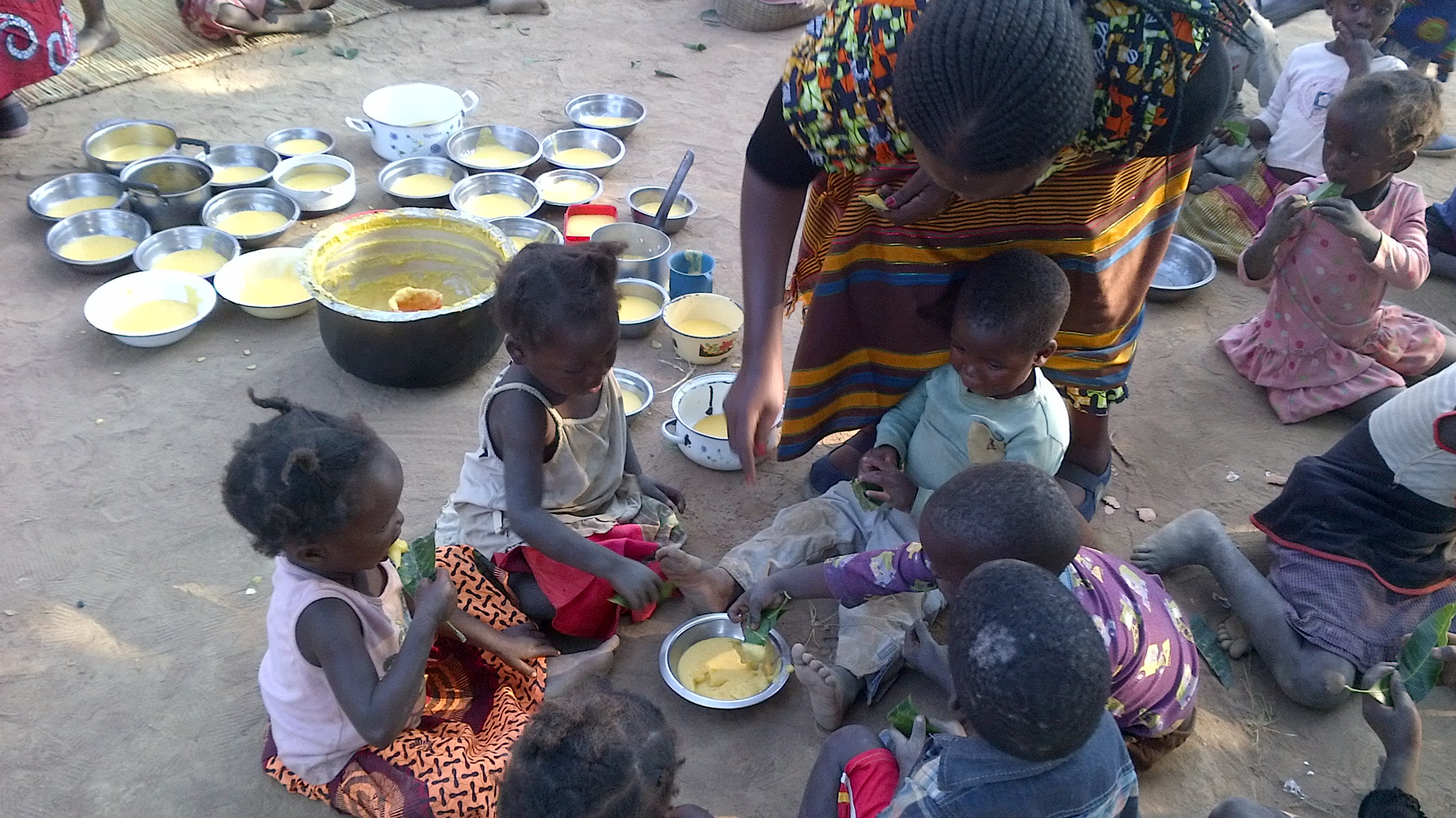 Zambia is a landlocked country in sub-Saharan Africa that borders the Democratic Republic of Congo to the north, Tanzania to the northeast, Malawi and Mozambique to the east, Zimbabwe and Botswana to the south, Namibia to the southwest, and Angola to the west. It covers a land area of 752,612 square kilometres. Administratively, the country is divided into ten provinces and 105 districts. Of the ten provinces, two are predominantly urban, namely Lusaka and Copperbelt. The remaining provinces – Central, Eastern, Muchinga, Northern, Luapula, North Western, Western, and Southern – are predominantly rural. The capital city is Lusaka, in the south-central part of the country.
Zambia is a landlocked country in sub-Saharan Africa that borders the Democratic Republic of Congo to the north, Tanzania to the northeast, Malawi and Mozambique to the east, Zimbabwe and Botswana to the south, Namibia to the southwest, and Angola to the west. It covers a land area of 752,612 square kilometres. Administratively, the country is divided into ten provinces and 105 districts. Of the ten provinces, two are predominantly urban, namely Lusaka and Copperbelt. The remaining provinces – Central, Eastern, Muchinga, Northern, Luapula, North Western, Western, and Southern – are predominantly rural. The capital city is Lusaka, in the south-central part of the country.
Zambia is broadly divided into three agro-ecological regions and 20 livelihood zones (FEWS NET, 2014). The three regions are classified as follows: 1) low potential, semi-arid and arid plains and valleys with an annual rainfall of <800mm (mainly in the southern part of the country); 2) high potential plateaus, rainfall 800-1,000mm (broadly central part of the country); and 3) northern high rainfall areas, rainfall of >1000mm (northern parts of the country). Northern Province is around 850km from Lusaka. It is in the third ecological region outlined above and is around 1,200 metres above sea level. It consists of eight districts and is part of the Rift Valley.
Self Help Africa development programme
In January 2013, Self Help Africa (SHA) began a five-year, Irish Aid-funded development programme in two districts in northern Zambia targeting around 90,000 persons focused on two key areas: sustainable agriculture and nutrition. The overall goal of the Irish Aid Local Development Programme (IALDP) was to improve the livelihoods, health status, food and nutrition security of poor households in Northern Province, with a particular focus on women and vulnerable groups. This will be attained through implementation of an integrated livelihoods programme focusing on increasing agricultural production and productivity; promoting improved nutrition and health education; and providing technical assistance to district authorities to improve delivery of social services to local communities.
A number of studies were conducted at the start of the programme to better understand the context. These included a baseline study and an Individual Household Methodology (IHM), which is similar to a Household Economy Approach (HEA). The IHM gave information on the livelihood zones and ranking of wealth groups. These were conducted during 2013. In September 2014, a Knowledge, Attitude and Practice (KAP) study was completed in Mbala District to understand better practices around health, hygiene and in particular feeding practices for children under five years old. At the end of 2014, a Nutrition Survey was conducted in Luwingu District to access the nutritional status of children under five, with a particular focus on levels of chronic malnutrition (see Table 2). Interestingly, the KAP survey indicated very high levels of illiteracy among the women interviewed. Even though 53% had attended formal education, 75% could not read and write. As can be seen from Table 1, infant feeding practices are sub-optimal; in particular, there is extremely poor dietary diversity and low frequency of meals.

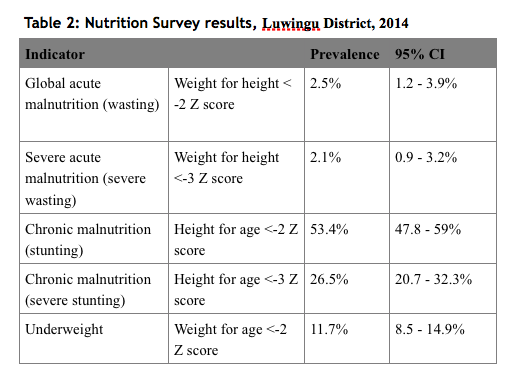
A national food consumption and micronutrient status study undertaken in 2014 in two provinces (Northern Province and Luapula Province) indicated a 40% prevalence of anaemia in pregnant women (Hb.<11mg/dl) and around 23% prevalence in non-pregnant women (Hb. <12mg/dl) in Northern Province (Halimatou et al, 2014). The prevalence for children aged 6-59 months in the same study was 54% (Hb <11mg/dl).
Overall focus of the programme
 As SHA had not previously worked in Northern Province, it took a number of months to become operational – recruiting staff, setting up offices and linking with the various relevant authorities. The programme is focused in two districts, Luwingu and Mbala. The estimated population of Luwingu District is 134,426 and 213,254 for Mbala (2010 census). The programme targeted a total of 16,000 households (HH); 6,000 from Luwingu District and 10,000 from Mbala District. This is a target population of around 90,000 beneficiaries. The programme has three main objectives:
As SHA had not previously worked in Northern Province, it took a number of months to become operational – recruiting staff, setting up offices and linking with the various relevant authorities. The programme is focused in two districts, Luwingu and Mbala. The estimated population of Luwingu District is 134,426 and 213,254 for Mbala (2010 census). The programme targeted a total of 16,000 households (HH); 6,000 from Luwingu District and 10,000 from Mbala District. This is a target population of around 90,000 beneficiaries. The programme has three main objectives:
- To increase market-oriented sustainable agriculture production and productivity;
- To improve the nutrition and health status of vulnerable HHs in Northern Province; and
- To strengthen district authorities with increased planning and implementation capacity and improved service delivery for local communities.
Initially, the project had ambitions to reduce stunting prevalence. Following technical review, this was considered over-ambitious and the aim was revised to impact positively on household dietary diversity and IYCF practices.
The main mode of implementation is through working with groups identified by the communities. The livelihood enhancement groups (LEGs) are formed within the community and consist of around 45 members, with at least 60% female participants. These groups have been formed over a period of time (around two years). Within each LEG, a number of various trainings are given, initially on group dynamics formation and governance. Within the group, individuals are trained on various issues such as conservation agriculture, planting and harvesting various crops, animal husbandry, micro-finance, aquaculture and nutrition. Individuals are trained within the LEGs as Trainer of Trainers (TOT) and they, in turn, cascade training to other group members and the community at large. Simultaneously, inputs were given to some of the members, including various seeds (mainly pulses), small livestock (goats and chickens) and vegetable seeds and fruit tree seedlings. A pass-back/pass-on system was used in which ultimately all LEG members received some inputs. In around 25% of the LEG groups, Village Saving and Loan Associations (VSLAs) were formed, partly as a safety net system. Furthermore, around one fifth of all LEGs will become involved in micro-enterprise on a number of specific commodities, such as fish and beans.
Research
Within the IALDP, a percentage of the budget is allocated for research with part of the funding assigned to different sectors, including agriculture, aquaculture, nutrition and gender. This funding has been extremely valuable in supporting the completion of the KAP and nutrition surveys to date. However, Irish Aid has also funded CGIAR (see www.cgiar.org) through World Fish, Harvest Plus and the Center for International Forestry Research (see www.cifor.org) to conduct research linked to the IALDP. A number of studies are in process linked in with SHA staff and the local provincial research institutions. Studies include acceptability studies on orange maize, developing local fish foods for use in the fishponds, and a study on the use of wild foods (yet to be finalised).
Nutrition component
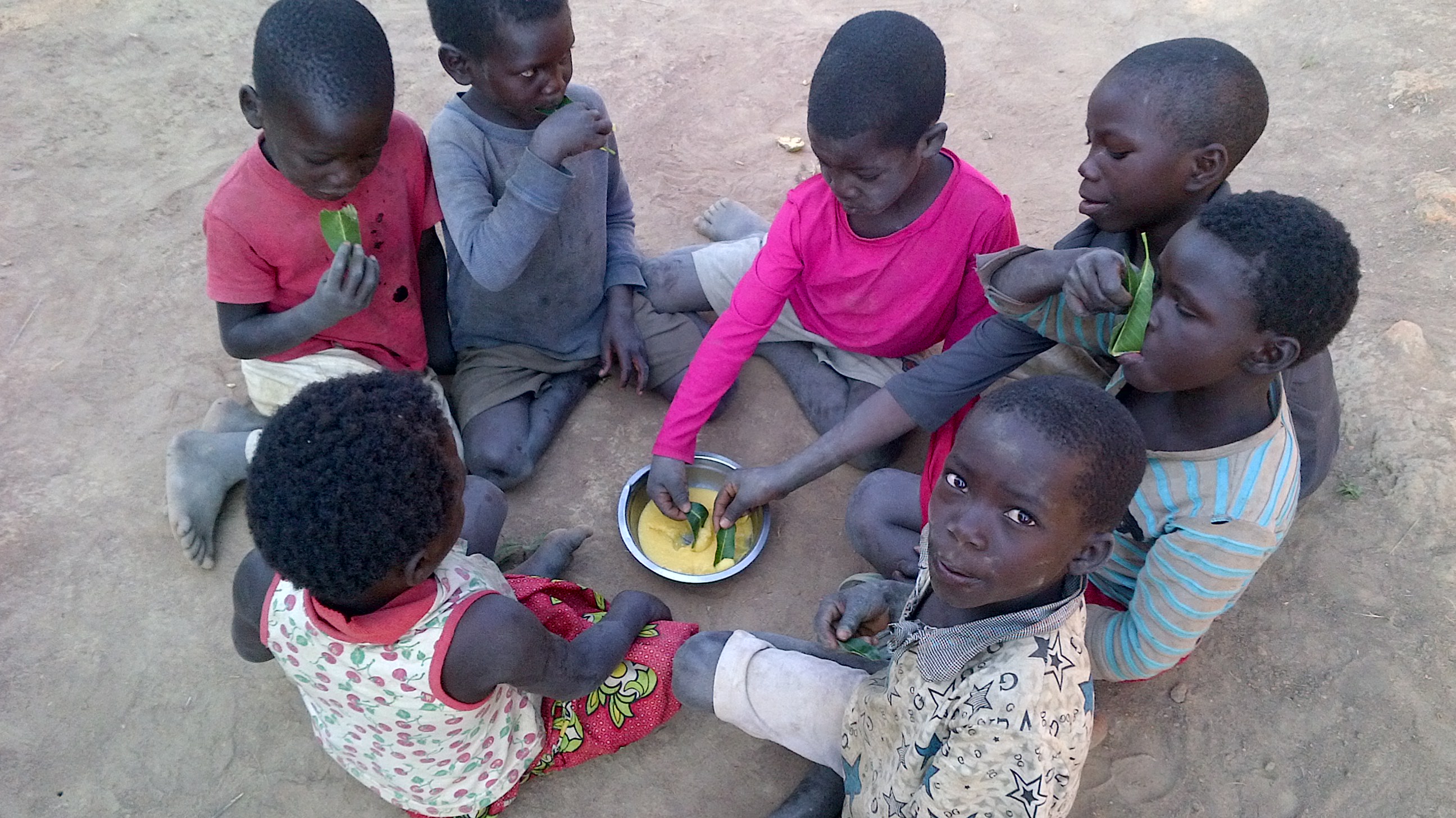 Realising that the prevalence of chronic malnutrition (stunting) in Zambia remains very high at 45% (Demographic Health Survey (DHS), 2007) and even higher in Northern Province at 49.3%, the programme has paid particular attention to nutrition at HH level. A specific focus has been to target the window of opportunity (1,000 critical days) from pregnancy to a child’s second birthday. This focus includes training on IYCF practices, nutrition and healthcare during pregnancy, hygiene promotion including safe processing and storage of foods, and improvement of dietary diversity at HH level through cooking demonstrations and discussions.
Realising that the prevalence of chronic malnutrition (stunting) in Zambia remains very high at 45% (Demographic Health Survey (DHS), 2007) and even higher in Northern Province at 49.3%, the programme has paid particular attention to nutrition at HH level. A specific focus has been to target the window of opportunity (1,000 critical days) from pregnancy to a child’s second birthday. This focus includes training on IYCF practices, nutrition and healthcare during pregnancy, hygiene promotion including safe processing and storage of foods, and improvement of dietary diversity at HH level through cooking demonstrations and discussions.
Community IYCF trainers
At the start of the programme two women (mainly mothers with young children) were identified from each LEG formed. Each training consisted of a group of 20 mothers/women, who received a six-day residential training conducted using the Ministry of Health (MoH)/UNICEF-accredited national trainers in collaboration with the MoH itself. All the mothers remained to the end of the training, completing the training course. A total of 225 people were trained in the IYCF TOT. Nutritionists from the MoH and Ministry of Agriculture and Livestock (MAL) from both districts were involved in the training, as well as the nutritionists from SHA.
This training incorporated information on health and nutrition during pregnancy, early initiation of breastfeeding, exclusive breastfeeding to six months, and good complementary feeding practises. It also incorporated training on good hygiene practices, feeding the sick child, child spacing and growth monitoring, as well as good practices regarding food preparation. The counselling cards adopted from the MoH were translated into the two local languages, Bemba and Mambwe, and each trained person received the counselling cards for use in the community. The translation of the material was also done in collaboration with the ministries to ensure accuracy and buy-in. The training material is mainly pictorial, which is important in the community where literacy levels are low.
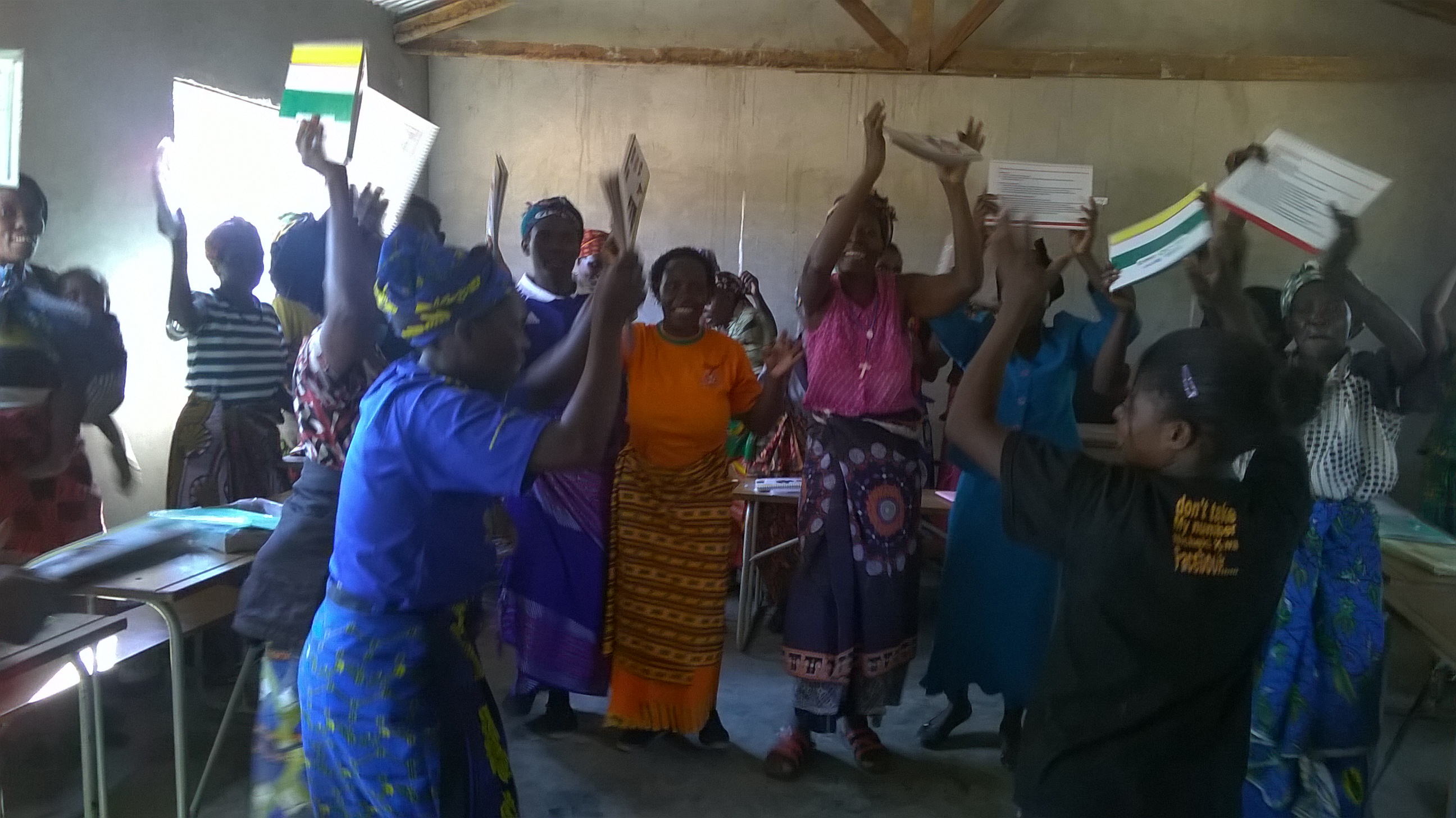 There was a deliberate follow-on cascade training with SHA staff supporting the community IYCF trainers to conduct training within the community. In both districts, each community IYCF trainer was responsible for training four women/men within their respective LEGs. The women who received the cascade training are called the mother-to-mother support group. They support women in the community but do not conduct ‘official’ training. It was decided to include men as well as women in the official TOT training as they are often the decision-makers in the household. Around 25% of those trained were men; those chosen are strong advocates and influential within the community.
There was a deliberate follow-on cascade training with SHA staff supporting the community IYCF trainers to conduct training within the community. In both districts, each community IYCF trainer was responsible for training four women/men within their respective LEGs. The women who received the cascade training are called the mother-to-mother support group. They support women in the community but do not conduct ‘official’ training. It was decided to include men as well as women in the official TOT training as they are often the decision-makers in the household. Around 25% of those trained were men; those chosen are strong advocates and influential within the community.
Cooking demonstrations and dietary diversity
In addition to the community IYCF training, the SHA team, together with the district nutrition specialists from the MAL and the MoH who are also well versed in the local foods and local nutrition challenges, have been involved in training the communities in good food preparation practices. Training modules from the National Food and Nutrition Commission (NFNC) of Zambia have been used. The main objectives of these community trainings are to equip mother-to-mother support groups and the communities at large with basic knowledge and skill of food requirements and good preparation practices. The topics discussed include:
- Food groups and their importance (energy, body building, vitamins and minerals);
- Cooking methods through demonstrations (boiling, roasting and frying);
- Balanced diets; and
- Malnutrition and monitoring nutrition status in children under five years of age.
Community IYCF trainers have been actively involved in food preparation demonstrations within the community and developing recipes using locally available foods. The agriculture component of the programme saw the introduction of a number of bean varieties within the LEGs. Soya bean was introduced as a new crop, together with a variety of bean high in iron content. There is a strong component of training on processing and use of soya, including introducing recipes as part of the training. Another area of focus in these trainings has been improving dietary diversity within the household, with better utilisation of foods yielding a more balanced diet for all members. The training has focused not only on the LEG members but also on the general community, which has shown huge interest.
Linkages with the health centres
The community IYCF trainers are strongly linked to the health centres. Many of these health centres are rural and isolated with limited human-resource capacity. The community IYCF trainers attend antenatal days and under-five growth-monitoring days. They are involved in various activities within the health centre; in particular, the health/nutrition education component with pregnant women and new mothers. The community IYCF trainers fill in a monthly activity report, which has been developed by the MoH. Some of the information collected by the community trainers includes the number of pregnant women, number of women with children under five years old, and number of women groups learning how to prepare different foodstuffs.
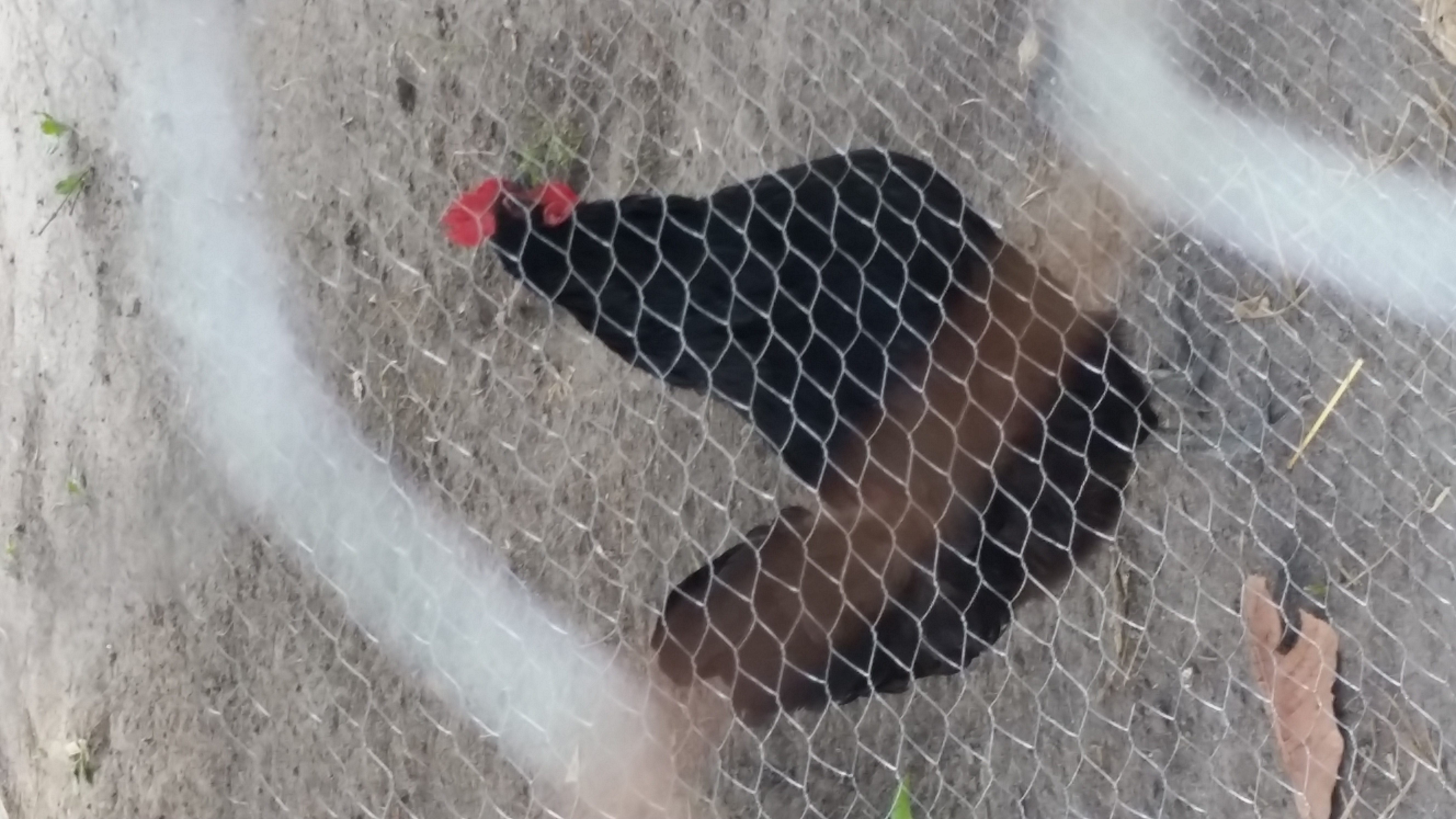
In general, those participating in the TOTs do not receive any incentives apart from receiving the IYCF participants’ manual, counselling cards and recipe books for their work. They also receive T-shirts so they are recognised as trainers. They occasionally receive a small incentive for attending meetings. At the start of the programme some of those trained received a bicycle, which was much appreciated.
Agriculture and aquaculture
In northern Zambia in general, livestock are not part of people’s livelihoods. Consequently the introduction of small livestock, including goats and chickens, has been highly appreciated and a strong component of the programme includes livestock management. Knowledge of beans was limited. New varieties were introduced, including soya beans and a bean that is high in iron. Training was included in processing and preparing these beans, especially the soya bean. Aquaculture is an important component of the programme, with smallholder farmers constructing fishponds, supply of fingerlings (a young fish, generally less than a year old and about the size of a human finger) and training on the various elements of the management of fish. CGIAR partners have also been involved with various complementary pieces of research in progress.
Results
Household dietary diversity scores will be calculated regularly during the implementation period (seasonally, twice per year). Other programme impact measures include number of trainings of IYCF trainers, cascade training, records of cooking demonstrations, assessment of knowledge on WASH (safe drinking water etc.), and appraisal of records from the health centres. Both a KAP survey and nutrition survey will be conducted at the end of the programme to assess knowledge and behavioural change, together with any changes in nutritional status.
The programme is currently only at the midterm point, so it is still too early to see what impact the various components of the programme may have on nutrition outcomes.
However, annual Food Consumption Scores (FCS) at the same time of the year, using the WFP FCS tool in November 2013 and 2014 in Luwingu District, indicate an improvement in dietary diversity. The acceptable diet has improved from 62% to 81% (see Figure 1). The introduction of pulses and use in the HH has been an important factor contributing to the improvement in dietary diversity. Data will be available from November 2015 twice yearly. Seven-day recall of foods consumed shows twice as much consumption of pulses and vegetables (number of days) and an extremely high increase in fish consumption in 2014 compared to 2013 (Figure 2).
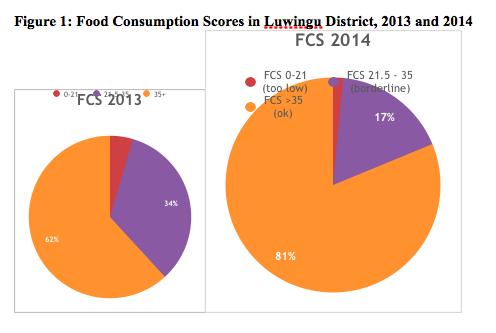
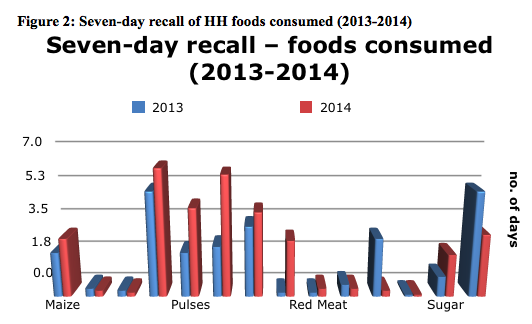
The initial KAP survey was conducted in 2014. There is a plan to have a repeat KAP survey at the end of the programme to determine if there has been a change in behaviour and practices, in particular with regard to IYCF practices, hygiene and health-seeking behaviours.
A nutrition survey was conducted in Luwingu at the end of 2014 which showed very high levels of stunting at 53.4% and extremely high levels of severe stunting (26.5%). A repeat survey will be conducted at the end of the programme, recognising that the short intervention timeframe will likely limit impact.
Discussion
The IYCF training of trainers with community members and deliberate cascade training has led to a considerable improvement in health and nutrition practices within the community. At the beginning, the training was thought to be beyond the capacity or excessive for non-health trained persons. However, there seemed to be substantial empowerment of those trained and the deliberate cascade training (identifying individuals for training) appears to be working extremely well. Those trained appear to be respected within the community and at health-centre level.
The use of the MoH/UNICEF-accredited trainers and materials has translated into more collaboration and ownership of the trained community members, not only by the line ministries but also by the community members.
The mixture of ongoing training within the community by the SHA nutritionists and the community IYCF trainers, together with the support by the community IYCF trainers to the health centres, ensures continuity of messaging and increases the level of sustainability.
Including men in the IYCF training appears to have been very beneficial as the information obtained is cascaded within different peer groups. It builds on trust within the community and allows men to be more supportive to their women folk .This also builds trust and allows women to have a voice where decision-making is concerned.
Technical staff from both ministries (MAL and MoH) are also involved in field monitoring and mentoring visits, together with the SHA staff. These activities are planned together to strengthen the working relationship and to allow for sustainability of the programmes in the communities. It is hoped that the strong collaboration with the ministries and the community will significantly impact on health and nutrition going forward.
For more information, contact: Mary Corbett
References
FEWS NET: Famine Early Warning System Network, 2014. Zambia Livelihood Zones and Descriptions.


